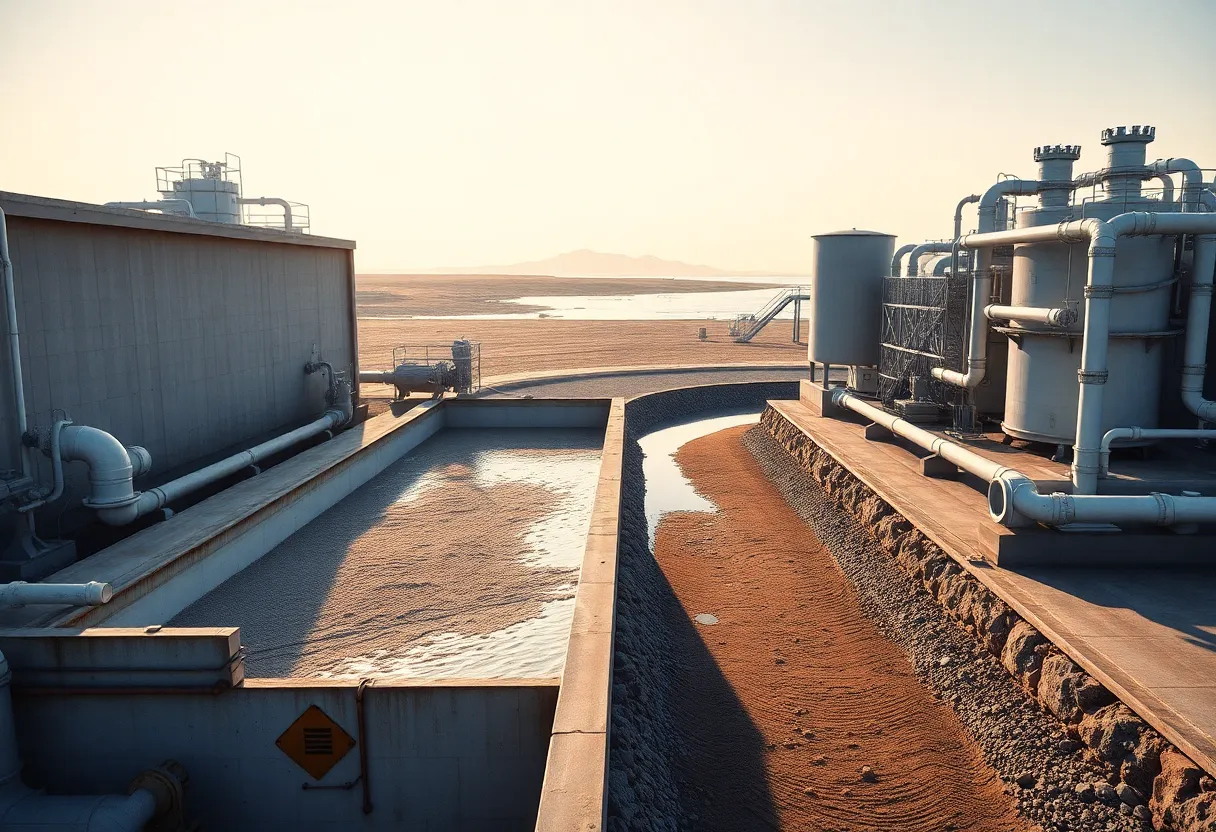Muscat, Oman, August 20, 2025
News Summary
Researchers and companies are advancing ultrasonic sea-sand desalination, a DAC-plus-desalination pilot, and a major financed desalination plant in Oman to secure materials and water for construction and industry. The ultrasonic device uses cavitation to reduce sand salt to 0.04% or lower while cutting water use compared with traditional washing. A pilot linking direct air capture with seawater desalination aims to remove about 1,000 metric tons of CO2 per year and produce fresh water. Separately, $130 million in financing was arranged for a 100,000 m³/day desalination plant west of Muscat to supply utilities and industry.
KIOST Ultrasonic Sea-Sand Desalination, DAC–Desalination Pilot in Korea, and Oman Barka 5 Desalination Financing: A Fresh Construction News Overview
The construction sector is increasingly leaning on sea sand as river sand shortages widen under environmental rules and overextraction. A new ultrasonic desalination device developed by the Korea Institute of Ocean Science & Technology (KIOST) aims to make sea sand viable for concrete by removing salt efficiently, reducing water use, and helping materials meet safety standards. In a separate development, a technology startup pursuing carbon removal has signed an agreement to pilot a project that merges direct air capture (DAC) with seawater desalination in South Korea, signaling a growing interest in integrated water and climate solutions. Meanwhile, financing for a major desalination plant in Oman demonstrates ongoing global investment in large-scale water supply projects. Taken together, these efforts illustrate a trend toward higher-skill desalination technology, safer construction materials, and climate-conscious approaches to industrial water use.
Why sea sand is rising in importance for construction
- River sand shortages are intensifying because of stricter environmental controls and heavy extraction, pushing builders to seek alternatives.
- Sea sand presents an opportunity for construction supply, but its salt content must be removed to prevent corrosion of steel reinforcements in concrete.
- Residual salt accelerates steel corrosion, weakens structures, and raises safety risks and costs if not adequately treated.
How the KIOST ultrasonic desalination device works
The device uses cavitation-driven washing that relies on ultrasonic energy to dislodge salt and fines from sand without relying on large volumes of water. Its design enables non-contact cleansing and strong particle clearance from bubble collapse, improving penetration and cleaning efficiency even in confined spaces. The system blends sea sand with water in a 1:2 ratio (one part sand to two parts water) and applies ultrasonic waves at 300 W or higher for about three minutes.
Laboratory and validation work show the method can reduce the salt concentration in sea sand to 0.04% or below, meeting conservative safety thresholds for use as concrete aggregate. The process is presented as water-sparing and faster than traditional sand washing, which typically requires several tons of water per ton of sand. The technology has been published in a peer-reviewed journal, underscoring its recognition in the scientific community.
Proponents claim the ultrasonic desalination method could extend the lifespan of concrete structures, bolster safety, and offer an environmentally sustainable and economically viable alternative to conventional sand washing. The technology’s developer also notes plans to scale up to handle larger volumes of sea sand more rapidly, reinforcing its potential impact on supply chains for construction materials in coastal regions.
Implications for construction safety and material standards
Desalinated sea sand enables construction materials to meet stringent safety standards related to salinity and corrosion risk. Industry guidelines call for tight control of salt content in sea-sand aggregates, with regulatory recommendations emphasizing very low salinity to minimize reinforcement corrosion. By achieving low-salt sea sand at scale, the approach aims to support longer-lasting concrete and safer structures in coastal zones where sea sand is utilized as an alternative to river sand.
Project Octopus: a DAC–Desalination pilot in Daesan, South Korea
A separate development involves a startup pursuing carbon removal through a novel use of desalination brine. The project, named Project Octopus, brings together a state-owned water utility, a wastewater treatment partner, and a private DAC technology developer under a memorandum of understanding. The aim is to build the world’s first fully integrated facility that uses seawater desalination in tandem with direct air capture to remove carbon dioxide from the atmosphere and manage water resources for an important petrochemical hub.
Key features of the Project Octopus concept include using desalination brine as a feedstock to generate a liquid sorbent that reacts with CO2 in the air, forming a limestone-like mineral that traps CO2. Fresh water is expected to be a byproduct of the combined process, which is notable given the water-intensive nature of DAC systems. The pilot will be connected to the electricity grid, meaning its energy footprint will be tied to the region’s energy mix, which is largely fossil-fuel based, raising questions about true emissions reductions and water security. The pilot aims to capture about 500 metric tons of atmospheric CO2 per year and filter an additional 500 metric tons of CO2 from smokestacks annually, presenting a modest start relative to broader emissions. Nevertheless, proponents view the project as a test bed for how carbon removal could align with industrial water needs.
The venture notes that a fully commercial facility could scale to capture as much as 500,000 metric tons of CO2 per year, positioning it as a potential climactic tool if scaled successfully. The pilot’s construction is planned for the current year with an eye toward late-2026 for a possible commercial breakthrough. The Daesan Complex, a focal point for the project, accounts for a sizable share of South Korea’s petrochemicals and is responsible for a substantial portion of the nation’s CO2 emissions, underscoring why integrating water management with carbon removal may be seen as valuable, even as critics point to energy intensity and ongoing dependence on fossil fuels for power.
Ongoing desalination financing: Oman’s Barka 5 project
In the Middle East, desalination continues to be a major growth sector. GS Inima, through its water services subsidiary, will operate the Oman Barka 5 desalination plant for 20 years on behalf of the Oman Power & Water Procurement Company. The facility is planned to produce around 100,000 cubic metres of water per day and to be located roughly 60 km west of Muscat. Financing for Barka 5 totals about $130 million, with the majority expected to come from the Export-Import Bank of Korea and Omani financial institutions, and the remainder from Hana Bank. When complete, Barka 5 is expected to boost water supply and is projected to generate substantial annual revenue. This project demonstrates ongoing international investment into large-scale desalination as a critical component of regional water security and industrial development.
Takeaways for the construction and energy sectors
- Innovative desalination methods, including ultrasonic desalination for sea sand and integrated DAC–desalination concepts, are at the forefront of reducing water use and emissions in coastal construction and industrial hubs.
- Low-salt sea sand can improve the durability and safety of concrete, helping builders meet strict material standards in areas facing sand shortages.
- Large-scale desalination projects continue to attract financing from international lenders, signaling ongoing confidence in water-security investments even as energy mixes evolve.
- Integrated approaches that combine desalination with carbon capture and water supply may offer strategic benefits for heavy industries, but energy intensity and grid dependence remain key considerations.
In sum, the latest advances reflect a broader push to solve material supply challenges, improve building safety, and explore innovative ways to address climate and water goals in tandem. The coming years will reveal whether these pilot projects translate into scalable, cost-effective, and broadly beneficial technologies for construction and industry alike.
Frequently Asked Questions
What problem does the KIOST ultrasonic desalination device aim to solve?
It targets the high salt content in sea sand, enabling its use as a safe concrete aggregate while reducing the risk of corrosion and extending the life of structures.
How does the device achieve desalination?
The system uses ultrasonic energy to drive cavitation and non-contact cleansing, resulting in salt and fines removal from sea sand with a 1:2 sand-to-water ratio and a processing time of about three minutes at 300 W or higher.
What are the target salt levels for sea sand used in construction?
The method aims to reduce salt concentration to 0.04% or below, aligning with regulatory guidance for safe use as aggregate.
What is Project Octopus?
Project Octopus is a pilot that combines direct air capture with seawater desalination to remove CO2 from the atmosphere and manage water for industrial use, using desalination brine to generate a CO2-trapping sorbent.
What are the CO2 capture targets for the pilot?
The pilot aims to capture about 500 metric tons of CO2 per year from the atmosphere and filter 500 metric tons per year from smokestacks, with potential scalability to 500,000 metric tons per year at full commercial scale.
What is the status and cost of the pilot and potential commercial facility?
The pilot is planned to start this year, with potential commercial-scale construction not expected until late 2026; estimated pilot construction costs are in the low millions, while the commercial facility could require hundreds of millions of dollars.
| Feature | Details |
|---|---|
| Sea sand desalination goal | Remove salt to enable use as concrete aggregate while preventing corrosion |
| Desalination method | Ultrasonic cavitation-assisted washing; non-contact cleansing; operates in confined spaces |
| Salt reduction target | 0.04% salt content or below |
| Processing conditions | Sand-to-water ratio 1:2; 300 W or more; three minutes per batch |
| Evidence | Results published in Scientific Reports; validated in controlled tests |
| Project Octopus | DAC–desalination pilot using desalination brine to form a CO2-trapping sorbent; freshwater byproduct |
| CO2 capture targets | 500 tCO2/year atmospheric + 500 tCO2/year smokestack (pilot); potential 500,000 tCO2/year at scale |
| Pilot cost and timeline | Pilot construction cost: a few million dollars; early commercial potential by late 2026 |
| Oman Barka 5 context | 100,000 m3/day capacity; operation for 20 years; financed around $130 million |
| Major financiers | Exports-Import Bank of Korea and Omani institutions; remainder from Hana Bank |
Deeper Dive: News & Info About This Topic
Additional Resources
- Scientific Reports: Ultrasonic sand desalination study
- Wikipedia: Desalination
- The Verge: DAC + desalination pilot (South Korea)
- Google Search: DAC desalination pilot South Korea
- Global Construction Review: Oman desalination plant financing
- Google Scholar: Oman desalination plant financing
- Smart Water Magazine: LG Chem $95M water treatment investment
- Encyclopedia Britannica: LG Chem water treatment
- MEED: Acciona signs Qatar 110 MIGD desalination contract
- Google News: Acciona Qatar desalination 110 MIGD





